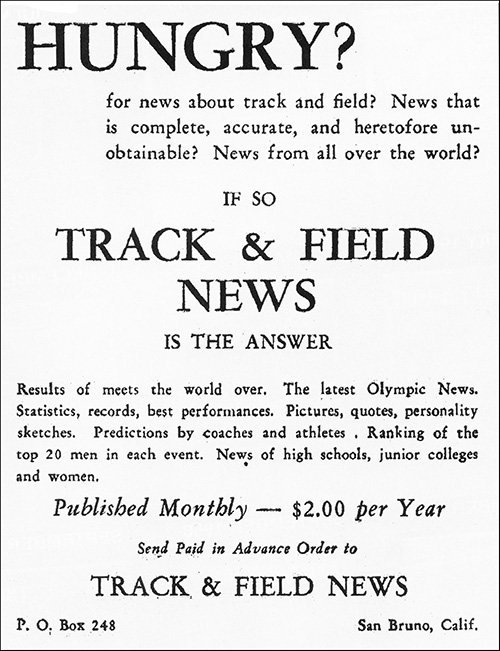
IN THE BEGINNING… The world of track journalism was void, and without form.
Then the Brothers Nelson came on the scene.
In the middle of 1947, Bert Nelson one day turned to his older brother Cordner and said, “It’s about time we started that track paper you’ve talked about.” And in February of 1948 the first edition of Track & Field News rolled off the presses.
For much of their lives the two visionaries had dreamed of doing a publication devoted solely to their favorite sport. They had been track nuts since attending the ‘32 Olympics as children, avidly scouring newspapers for every scrap of information they could find.
But what meager facts they did get never could satisfy their voracious appetites. Cordner reminisced in a 1997 interview, “Bert and I wondered why it was so difficult to get more information. But we talked about doing our own publication for years before we did anything about it.”
World War II was simply, he said, “a five-year time-out” in their musings. After the war, Bert bought a small newspaper in San Bruno, just south of San Francisco. Then came his fateful comment in mid-’47.
“But even after deciding to do it,” Cordner — who passed away in 2009 at age 91 — recalled, “we didn’t know how to do it.” They started by writing letters to every major college coach they knew of. They contacted newspaper writers. They persevered.
Recalling the early days half a century later, Nelson admitted, “Sometimes, I look back and wonder how we did it.” One letter went to Cal Tech coach Doc Hanes, who told the brothers about a young nut who might be of help.
Former sprinter Don Potts was 26 at the time and already a full professor of math at Northwestern. Cordner’s letter to Potts struck a gold mine.
“Not only was Don eager to help, he knew many more sources than we did,” Cordner said. “Most important, though, he told us about a young Italian who already had quite a reputation as a statistician.”
So Nelson wrote to Roberto Quercetani in Florence, who also replied enthusiastically. Cordner recalled, “On the very day the first issue was being finished, a long letter arrived from Roberto. It was full of great results we just had to get in.”

So T&FN was off and running. Cordner gathered results, wrote stories and did the editing, while Bert handled the business side. It was demanding, time-intensive work. By the summer of ‘48, Cordner wasn’t sure they would survive.
“The July ’48 issue was our low point,” he recalled. “I went to the ’48 AAU and told Lou Miller, a New York track writer, that I didn’t think we would last out the year.”
The brothers related their difficulties to Potts and Quercetani — who promptly volunteered to take over compiling the U.S. and world news. The Nelsons were thus freed up to focus on their own areas.
“All it took was contacting one real stat expert in a country,” Cordner assessed looking back. “Like Joe Galli in Australia and Harry Beinart in South Africa. I would write someone and he would contact somebody he knew — today we call that ‘networking,’ although we didn’t have the word back then.”
Similarly, a network of contributors developed in the U.S., many newspaper sportswriters but others just ultra-fans, like Jim Dunaway, George Grenier, Dick Bank and H.D. Thoreau.
“But without Bert, there wouldn’t have been a publication,” Cordner said of his brother, who died in 1994. “I’m an idea person, but he was best at following through on ideas. I’m sure I never would have done it on my own.”
By the 10th anniversary, Cordner could write to T&FN’s loyal readers, “I hope all of you are here for our golden anniversary.”
Well, T&FN has made it that far and further, to our semisesquicentennial. Yeah, really, that’s a word. There’s some debate as to whether 75 years is the Diamond Anniversary; some say that’s 60 years. In either case, please join us in the special section that follows as we celebrate a banner milestone — and look ahead with the hope you are all here for our 100th.
Links to further birthday features
T&FN’s Magic Carpet — The Tours Division